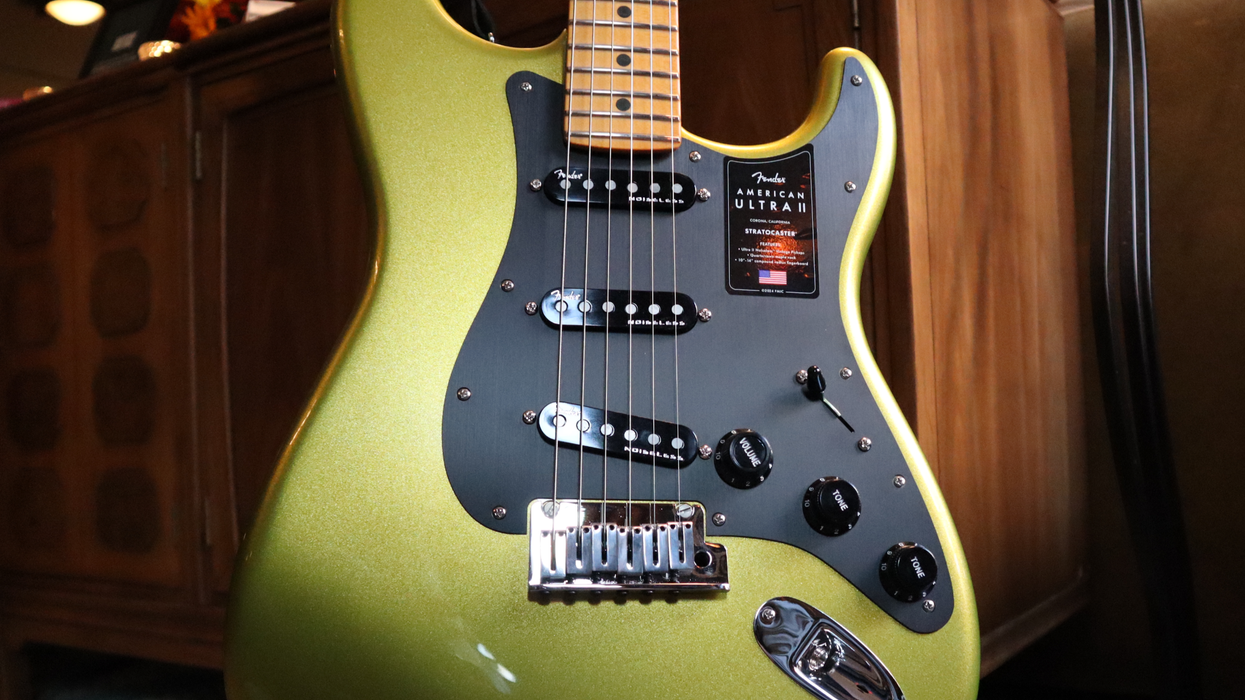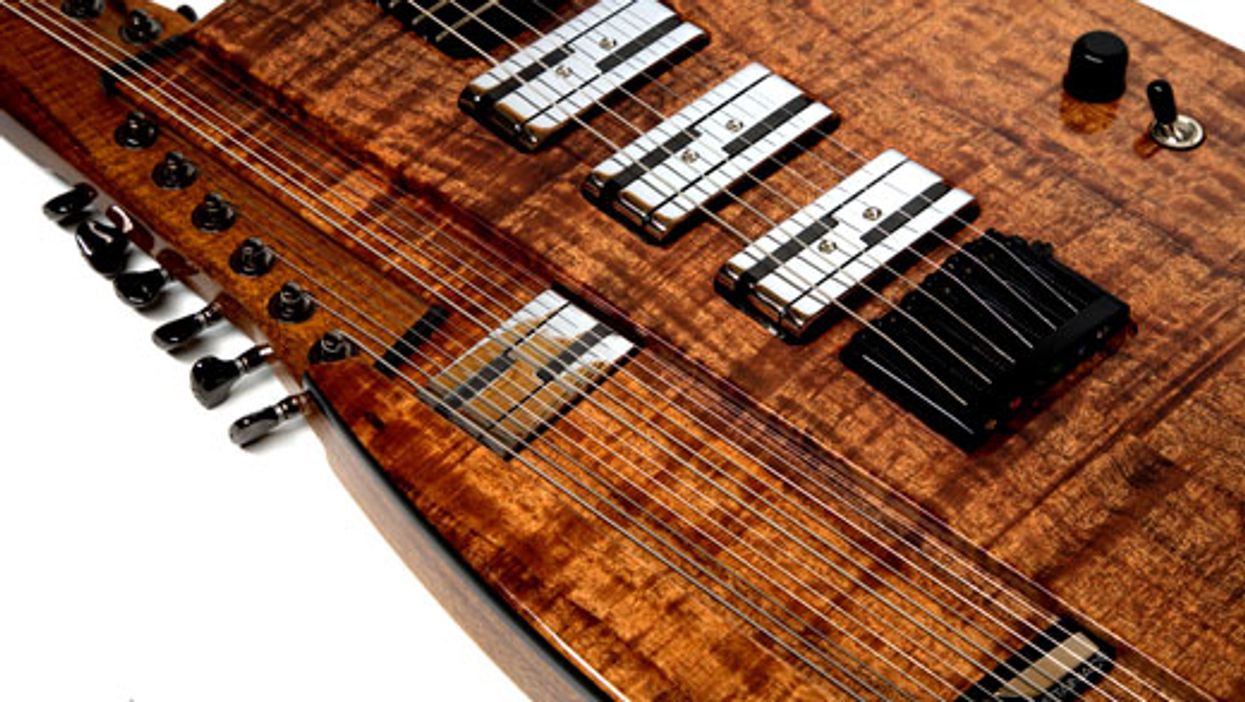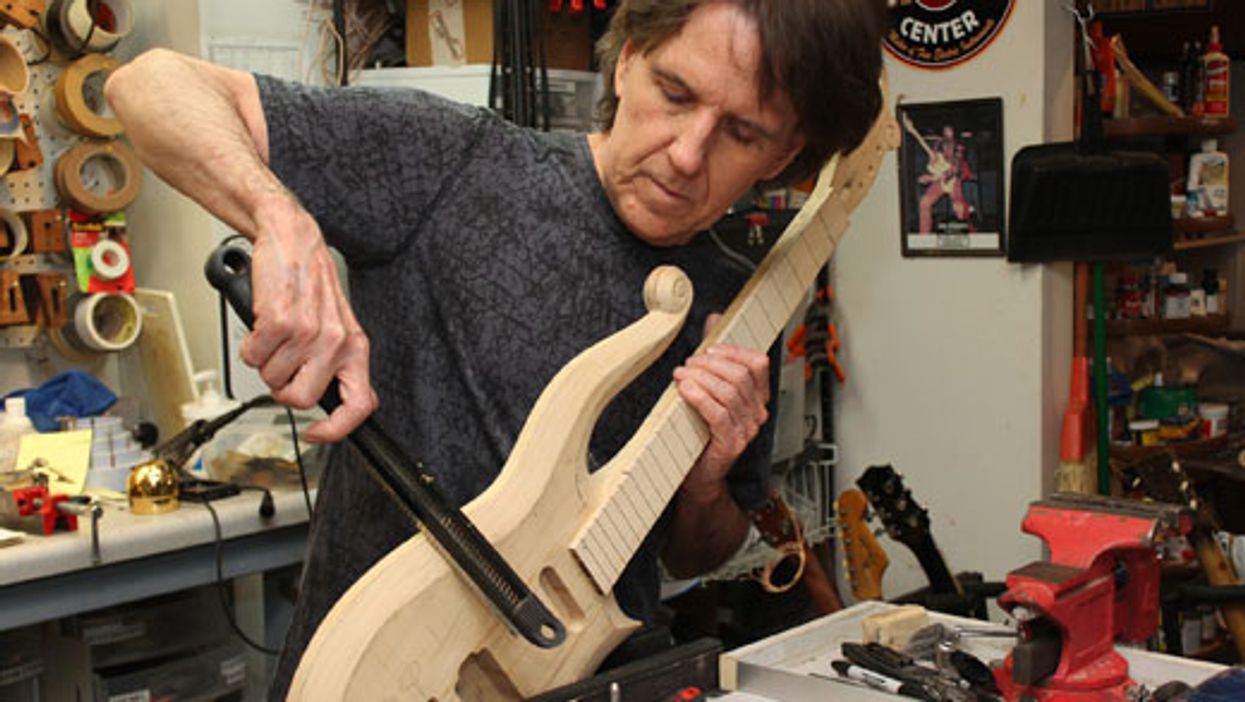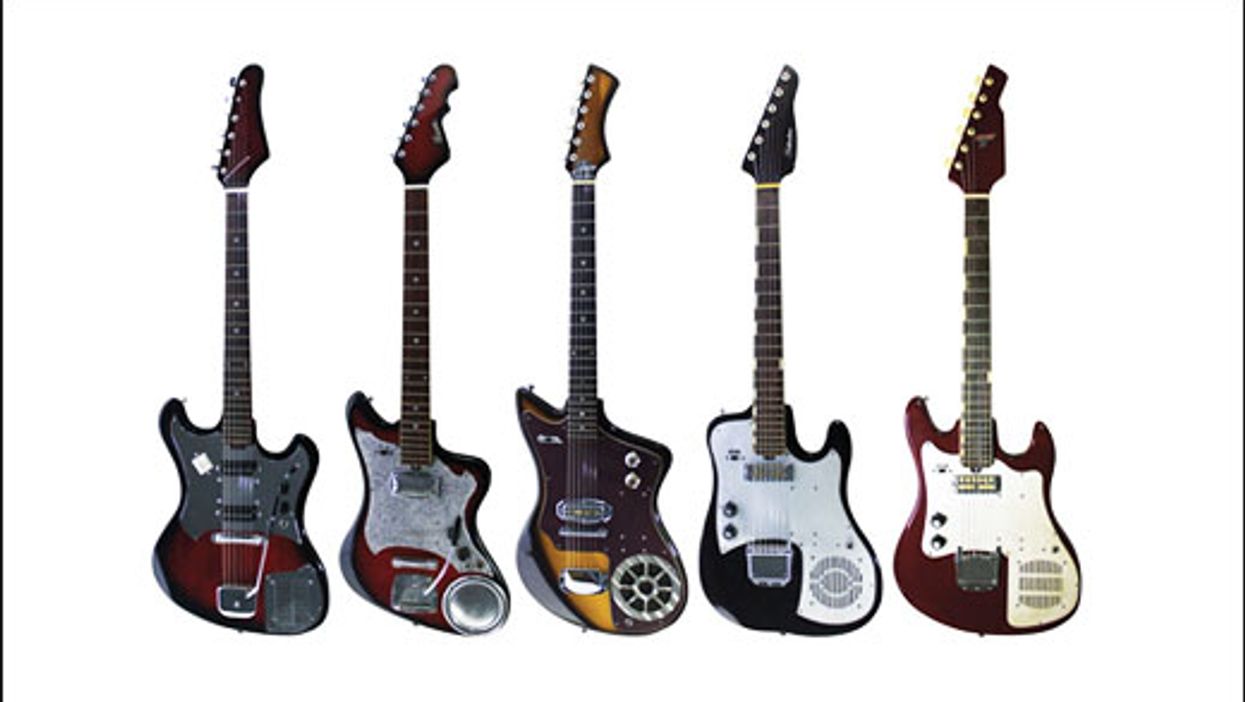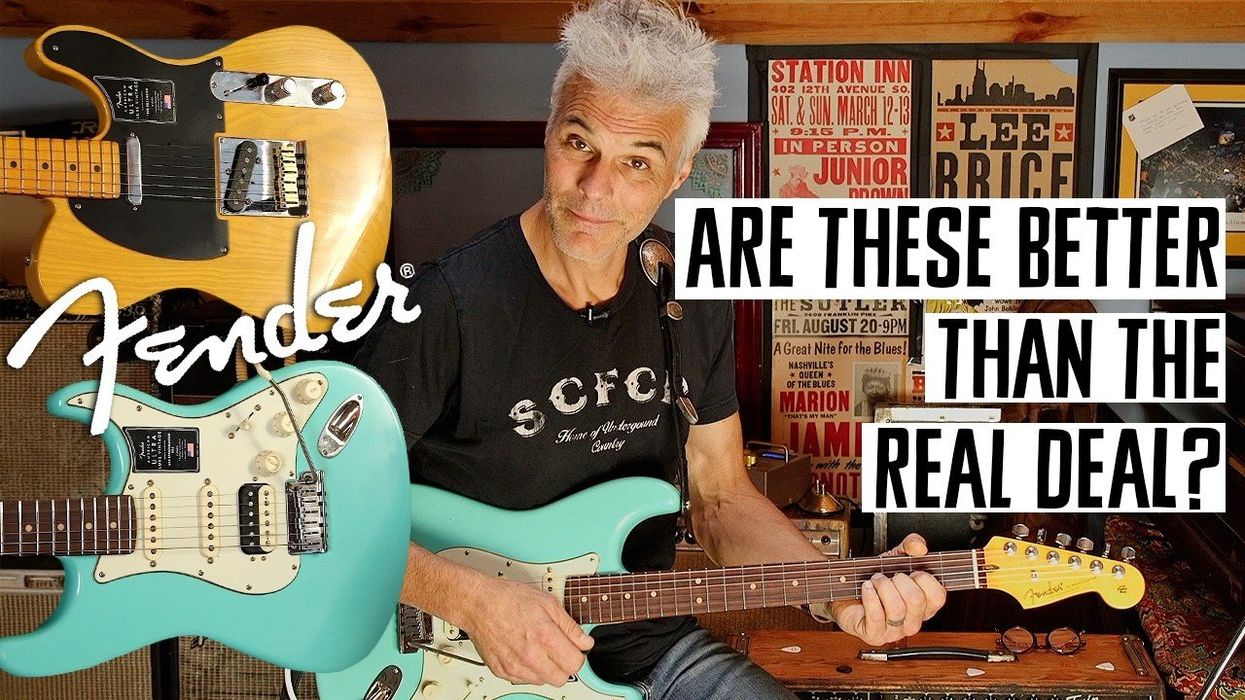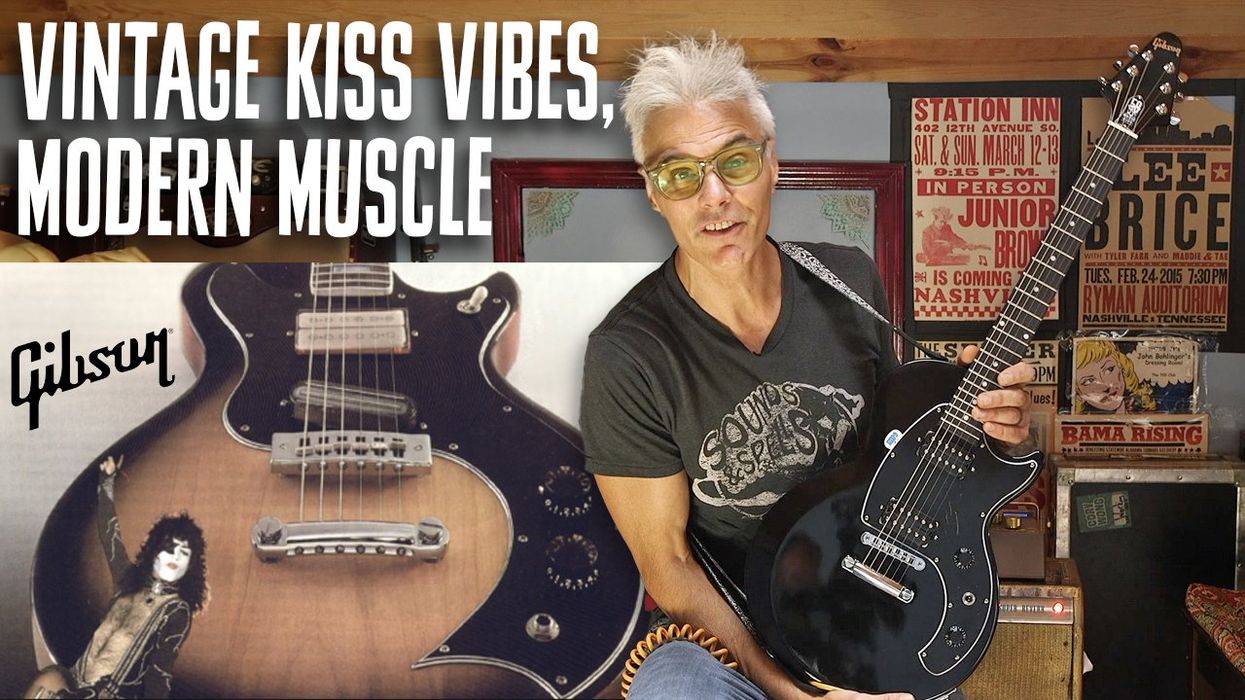[Originally published December 16, 2009]
As far as anyone knows, doubleneck guitars have been around as long as the guitar itself. Even still, guitars with more than one neck have always been a bit of a curiosity, never the norm. The far majority of players seem to have more than enough on their hands just working one set of strings. Some players, it seems, need more. So while we may take multi-neck guitars for granted as mere novelties, the roots of their existence, like many innovations, lie in necessity. The impetus for a guitar with more than one set of strings lies in two needs: tone and tuning. The player needs either an alternate sound or pitch from the main instrument.
One of the earliest examples of a multi-neck guitar is dated to circa 1690, and built in the style of the famed Alexandre Voboam. It is a small-sized guitar with an even smaller, almost ukulele-sized, guitar grafted to its treble side. This instrument would have been made for a professional musician who performed with an ensemble or orchestra. The purpose of the second set of strings was to allow the player to transpose on the fly.
Throughout the 18th and 19th centuries, multi-necked guitars appeared on a semi-regular basis, but never in any kind of large-scale production. It wasn’t until the 1890s, when modern manufacturing methods facilitated a sharp increase in instrument production, that multi-neck instruments could be made and distributed in the kind of scale that would allow for widespread usage. As multi-neck guitars began to be used more frequently, there became a greater and greater demand for the instrument—it built upon itself.
The double-neck guitars of the 1890s reflected the tastes of the times. What became popular were things like harp guitars, lute guitars and mandolin guitars. The playing method differed from instrument to instrument. On the harp guitar, the extra strings were intended to mostly drone along with the guitar. On a mandolin guitar, one neck was played at a time. While none of these instruments set the world on fire, they did achieve enough popularity to establish the concept of a multi-necked guitar as a viable instrument.
The Early Lap Steels
As we know, the popularity of Hawaiian music in the late 1910s and ‘20s led to the emergence of the guitar—particularly the lap steel guitar—as an accepted instrument in popular music. The portability and accessibility of the guitar lent itself to usage across the entire spectrum of society, from front-porch pickin’ to ballroom jazz. The need for more volume from the instrument lead to the amplification and electrification of both lap steel and Spanish-style guitars in the late 1920s.
The earliest multi-neck electric guitars were lap steels. The famed lap steel guitarist Alvino Rey, who seemed to have had a hand in a multitude of early electric guitar inventions, claimed to be one of the first electric lap steel players to use instruments with more than one neck. Rey, like many other lap steel players before and after, knew that the instrument required multiple tunings to keep up with a band or orchestra. He found that the ultimate solution was to have more than one set of strings on the same instrument. By the mid-1930s Rey had commissioned a dual-neck steel from Gibson. By the end of the decade there were a number of steel players utilizing two- and three-neck instruments.
Immediately after the end of World War II, a number of different builders—Leo Fender and Paul Bigsby to name two—made businesses of building multi-neck steel guitars. Indeed, multi-neck steels were a core part of the Fender business throughout the 1950s. But steels were not the wave of the future, and both Fender and Bigsby would focus the bulk of their efforts on the single-neck electric Spanish guitar. But that didn’t mean the end of multi-neck guitars. In fact, it was just the beginning.
Doubleneck Spanish-style electric guitars may have existed prior to World War II, but these would have been one-off pieces. In the years just after the war, most manufacturers—players as well—were just trying to get their footing with the new standard of electrification. Once this new standard was accepted, people began to expand their vision of what an electric guitar could be, and what it could do. It was the economic and cultural climate of the 1950s that brought the doubleneck electric guitar from the freak show onto the main stage of music.
Doublenecks With a Purpose
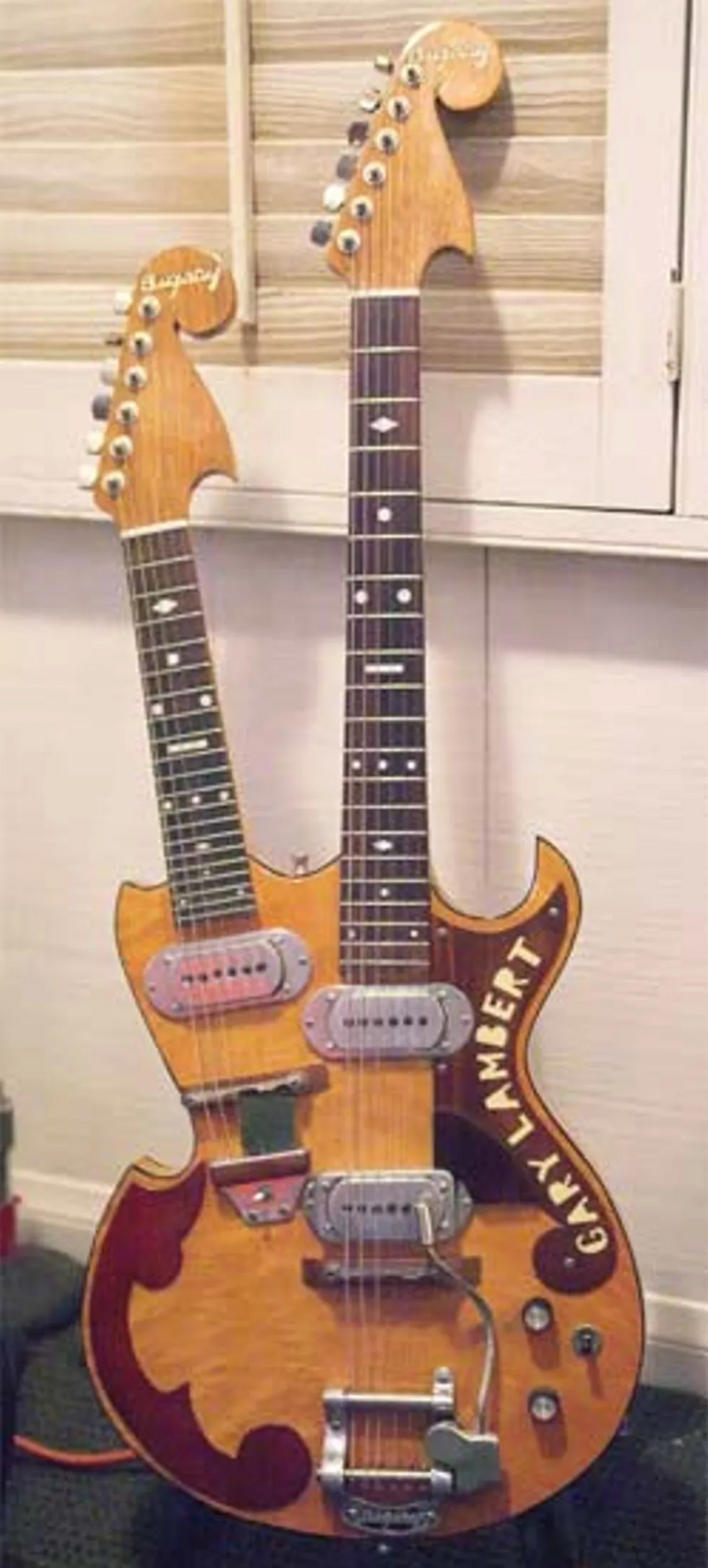
A replica of Grady Martin’s doubleneck Bigsby made in the ‘80s by R.C. Allen for Gary Lambert, the rockabilly picker who played with Glen Glenn and Eddie Cochran. It diverges from Paul Bigsby’s original in a number of details, most noteably the lower bout ornament, vibrato assembly, pickup and control configuration and (rather obviously) the pickguard.
Photo courtesy of Rick Gould
One of the earliest examples of a doubleneck electric guitar made for onstage use was a doubleneck electric guitar and mandolin made in 1952 by Paul Bigsby for country singer Grady Martin. The guitar was a solid maple instrument featuring a standard six-string guitar neck paired with a mandolin neck. The six-string neck used a Bigsby vibrato and three P-90-style pickups. The mando neck had a single pickup. Martin used this guitar throughout the ‘50s. The Grady Martin model wasn’t the first, or last, doubleneck that Bigsby would make. All totaled, it’s believed Bigsby made about a half-dozen doublenecks.
Doubleneck guitars were still an extreme rarity when Jimmy Bryant stepped in. Bryant, the six-string virtuoso whose many recordings from the late 1940s and early 1950s brought a Django Reinhardt-fluency to country swing soloing, was an early adopter of the solidbody guitar. Possibly the first Fender endorsee, Bryant used an early Broadcaster to great effect. In 1954 Bryant was looking for new levels of showmanship in his playing, and new ways to get the sounds in his head out to the world. In a nutshell, Bryant was looking for an instrument that would allow him to play melodic harmonies without having to team up with another guitarist. He paired with Stratosphere Guitar Manufacturing Co. of Springfield, MO. Whether it was Bryant who approached Stratosphere or the other way around, Stratosphere owner Russ Deaver had just the thing to solve Bryant’s dilemma: a doubleneck electric guitar that was different from any before or since. The Stratosphere had both a six- and twelve-string neck, maple fretboards and P-90-style pickups. The body on the Stratosphere was a bit of a blob. The Stratosphere Twin is acknowledged as the first doubleneck electric—as well as the first 12-string electric—offered to the public for sale (unlike the Bigsby, which was custom order-only). The tuning of the Stratosphere was a big departure: on the twelve-string neck the courses were tuned in either major or minor thirds. The complex tuning of the Stratosphere required the player to almost completely relearn the fretboard. Bryant used a prototype Stratosphere Twin at a session in September of 1954. Chet Atkins himself also used a Stratosphere on the tune “Somebody Stole My Gal.” Not much was seen of the guitar after.
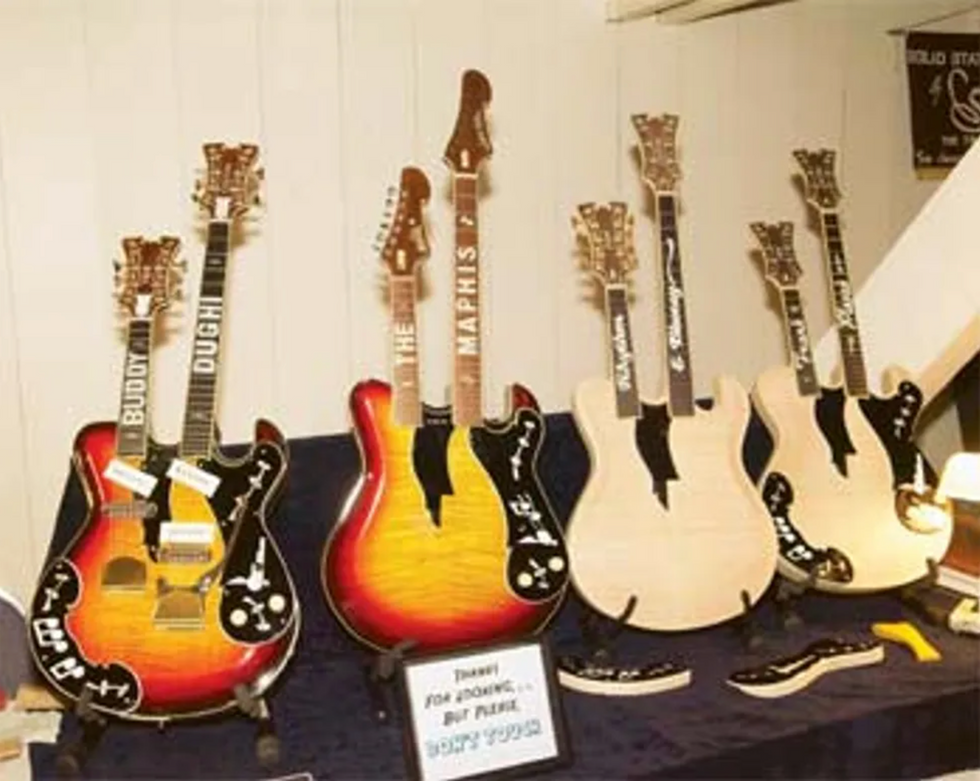
Custom versions (in various stages of completion) of Terry McArthur’s Moseley-inspired recreation, “The Maphis” by TNM Guitars.
Photo courtesy of Rick Gould
Semie Mosely may have done more for establishing doubleneck electric guitars than any other individual. As an apprentice with Paul Bigsby when he was barely out of his teens, Moseley got the opportunity to work on the guitars of many famous players. Picking up the luthier’s trade rapidly, Moseley learned how to craft every single part of the guitar himself, including pickups, vibrato tailpieces, knobs and other plastic parts. They were also durable, with many examples still in existence. He also learned to be unafraid of invention, innovation and making guitars way, way out of the norm. Going into business for himself in about 1954, he began building solidbody guitars for players in and around Southern California. In 1954, Moseley made doublenecks for Joe Maphis and Larry Collins of the Collins Kids. He became known as the go-to guy for multi-necked instruments and eventually made more pieces for Maphis and Collins, as well as for stringburner Phil Baugh and others.
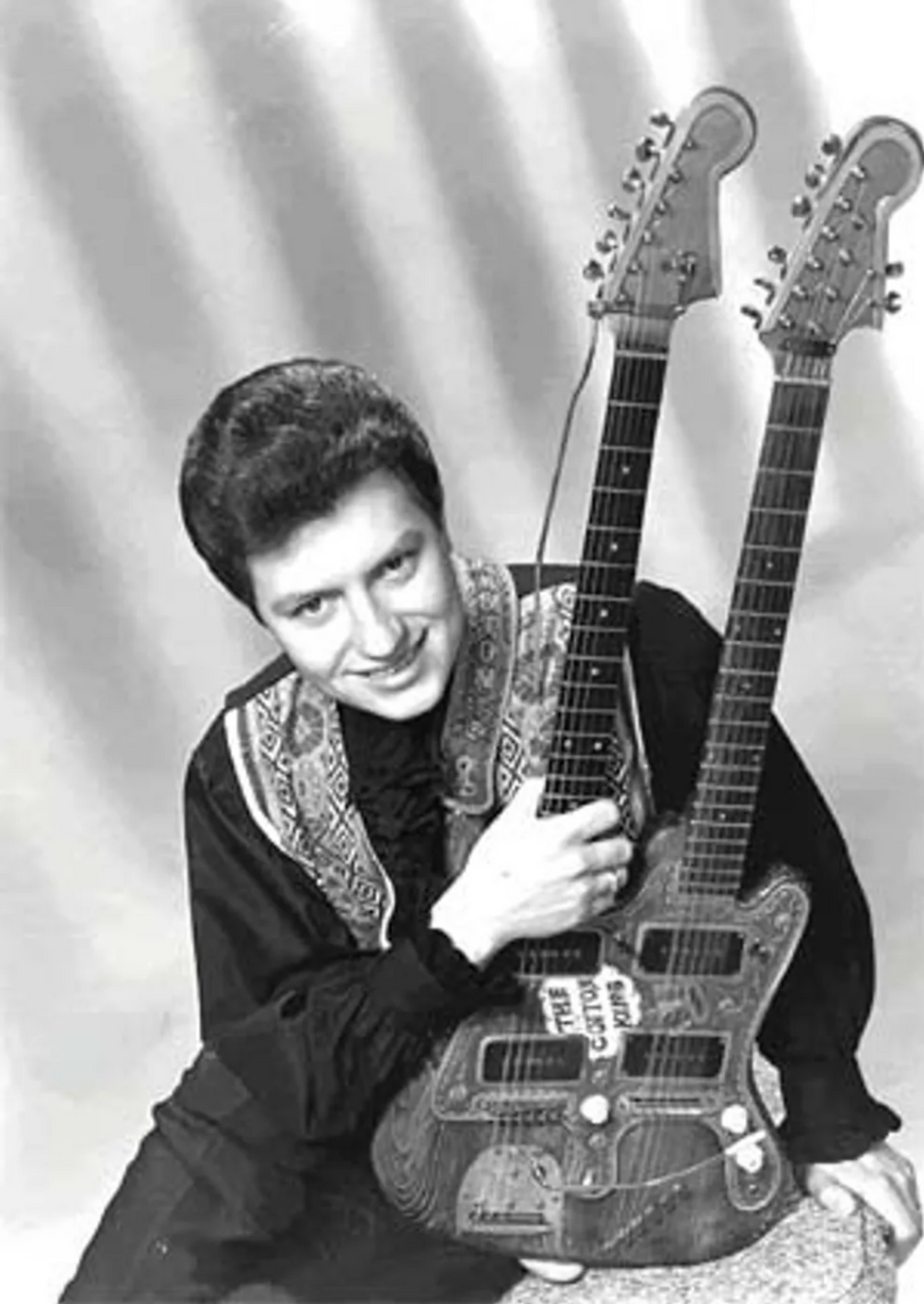
Sherwin Linton in 1967 with the doubleneck he built in 1965 using a Fender Jazzmaster neck and vibrato tailpiece. Four of the strings on the 12-string neck use banjo tuners through the back of the headstock, so they’re not seen in the photo. Sherwin says he “finished it in blue with the woodgrain showing through and it was and still is very pretty.”
Photo courtesy of Sherwin Linton
Throughout the ’50s, one-off and homemade doublenecks made appearances across the scene. Herbie Treece and Sherwin Linton are two that come readily to mind. Both pickers in the country circles, each played homemade doublenecks. Treece’s guitar was a stylish axe with dual six-string necks of differing scale, and Linton’s homemade doubleneck had a revolving cast of six-, eight-, and twelve-string necks with features such as B-benders and headstock-mounted vibratos. Linton used his doubleneck on the aptly named album, “Hello, I’m Not Johnny Cash.”
The Big Boys Step In
In 1958, Gibson introduced two doubleneck electric instruments, the EDS-1275 Double 12 and the EMS-1235 Double Mandolin. The first Gibson electric doubleneck, however, was built a year or two earlier as a custom order. Seeing the possibilities in the model, Gibson built a number of samples, some of which they exhibited at the 1957 NAMM show. Enough positive reaction was garnered that the company put the models in the next catalog, but very few of the instruments were actually produced. Initially, both of these instruments were thinline hollowbodies, 1-7/8" deep. The EDS (Electric Double Spanish) had two 24.75" scale necks, the upper a twelve-string, the lower six-string. The EMS (Electric Mandolin Spanish) had a 13-7/8" scale six-string neck in the upper position and a 24.75" scale six-string neck in the lower position. Both models had a two-piece solid spruce top with maple sides and a one-piece maple back. Colors available were white, black and sunburst. The dual-cutaway shape of the thin-lines was a precursor to the SG-style solidbody which both instruments transitioned to in 1962.
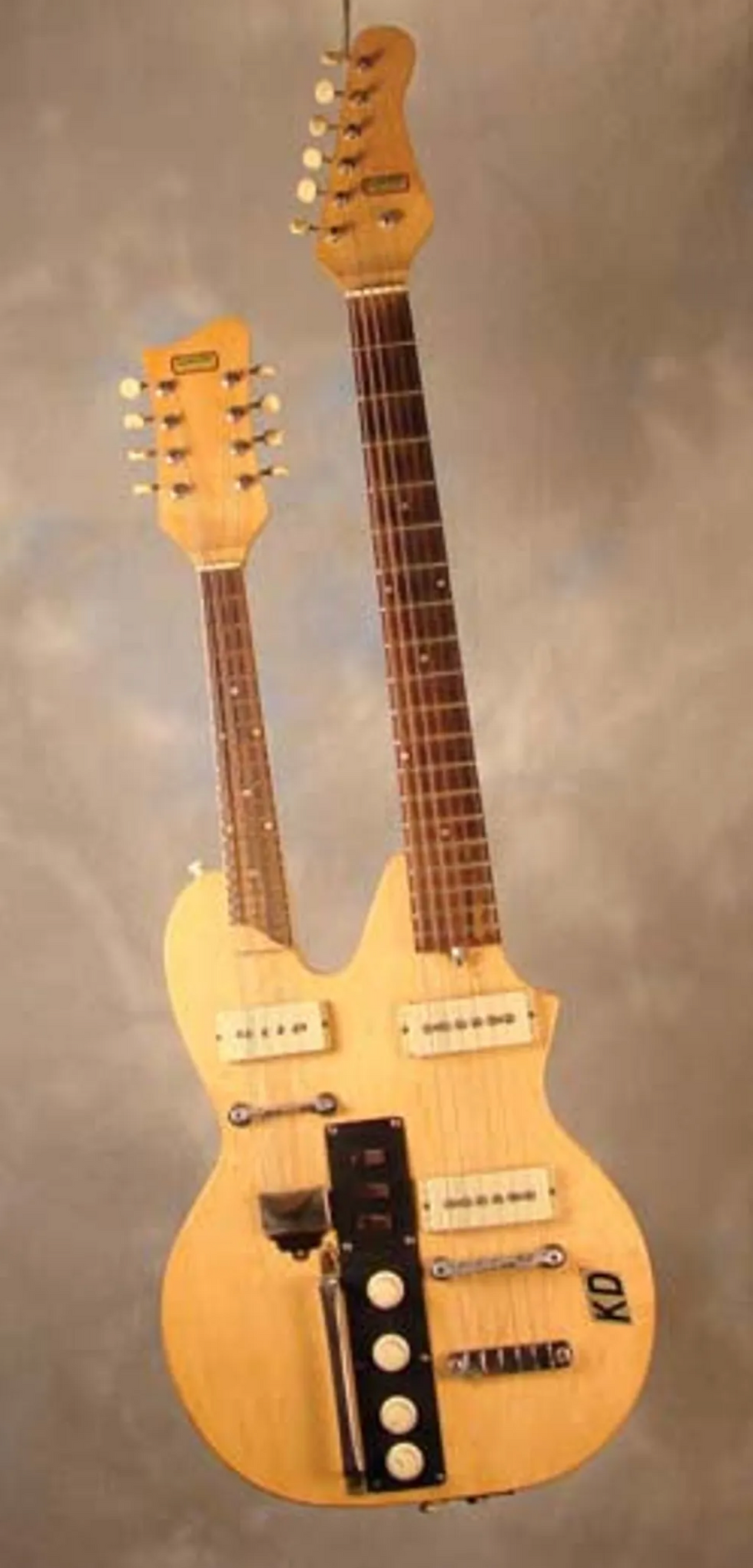
Carvin #1-MS Professional Double-Neck.
Photo courtesy of Dave Isaac/Hollywood Vintage Room
In their 1959 catalog, the Carvin Guitar company introduced two doubleneck models. The #4-BS Professional Doubleneck featured dual 25-1/8" necks; one a six-string guitar, the other what would amount to be a (very) short-scale bass. The #1-MS was a guitar and mandolin combination with one 25-1/8" scale guitar neck. The body was maple and similar in shape to their other guitars. The electronics on the Carvins were a bit unique. Each unit had two P-90-style pickups on the guitar and a single pickup for the bass and mandolin, respectively. Whereas many other doubleneck models would have had a switch to select which neck you were playing, the Carvin used the pickup selector to do this job. Position 1 of the pickup selector would be the bridge pickup of the guitar. Position 2 would be the guitar’s neck pickup and position 3 would be the single pickup of either the bass or mandolin. Carvin continued to offer the #4-BS and #1-MS throughout 1964 when they redesigned the pair. Carvin offered the doubleneck option throughout the ‘60s, and continued to help players satisfy their doubleneck cravings consistently throughout the years, making them one of the longest-lasting and most prolific producers of doubleneck guitars and basses.
For the 1961 model year, Gretsch introduced one of the more unique multi-neck offerings ever to come from a major manufacturer. The Bikini was actually three units, a guitar (6023), a bass (6024), and a doubleneck bass and guitar (6025). The concept was that you could use one body and slide in either a bass or a guitar neck. To make things slightly more complex, the body also folded down the middle on a piano hinge, becoming known as a “butterfly.” A player also had the option of combining separate butterfly back components to make a doubleneck. The guitar was 25-1/2" scale and the bass was 29-1/4" scale. Electronics, pickups, tone and volume controls were self-contained in each respective neck shaft. The guitar was a good idea in theory but not in practice, and was difficult both to produce and to operate.
Throughout the rest of the 1960s and 1970s, Gibson was the only major manufacturer to consistently offer an electric doubleneck. Mosrite kept the Joe Maphis doubleneck in its catalog up until the latter part of the decade, and Rickenbacker occasionally produced guitar and bass doubleneck combos. Other manufacturers produced doublenecks only as a custom order. By and large, the doubleneck moved into novelty status with only Jimmy Page of Led Zeppelin using one to any effect. Rick Nielsen famously paired with Hamer on a number of extreme multi-neckers, and in the 1980s some metal bands made use of the shock factor of the instrument to add to their visual appeal. In the late 1990s and early parts of the 2000s, retro appeal brought back some doublenecks into the realm of “guitar geek” status.
Some of the most enlightening moments in guitar learning have come for me at the Museum of Making Music. Located at NAMM headquarters in Carlsbad, CA, the Museum not only preserves the history of the music instrument industry but teaches the history of music instruments to the public. I was lucky enough to work at the museum doing a number of things, none more gratifying than giving tours to youngsters. Once while giving a tour to a group of Brownies—girls between the ages of seven and nine—I walked up to a case holding an incredibly rare Bigsby doubleneck built for J.B. Thomas. It’s a beautiful piece with a maple top and one regular-scale guitar neck and one mandolin neck. I asked the Brownies the question, “Now why would a guitar have two necks?” The girls were silent until one of them, in a whisper quiet voice, said, “So you can rock and roll?”
A great answer, and probably not too far from the truth.

